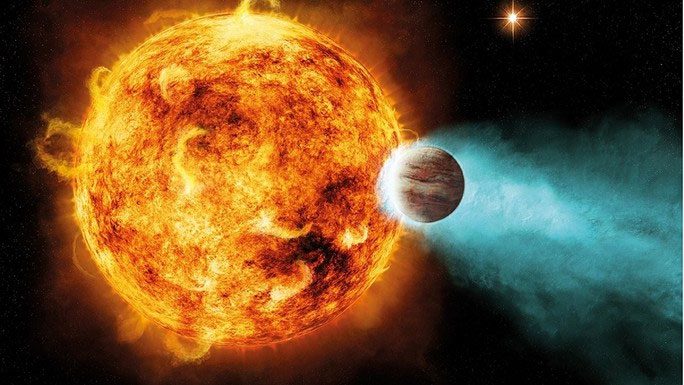A newly discovered exoplanet has revealed extremely perplexing characteristics, leaving scientists bewildered and contemplating terrifying scenarios about its past.
According to Science Alert, this is planet TOI-332b, which orbits a red dwarf star located 727 light-years from Earth.
Measurements based on the planet’s impact on the light of its host star each time it transits allowed the team of scientists, led by astrophysicist Ares Osborn from the University of Warwick (UK), to calculate that it is a world with a radius 3.2 times that of Earth, completing an orbit around its star every 18.72 hours.

Graphic depicting a giant planet with its atmosphere blown away – (Image: SCIENCE ALERT).
Interestingly, this planet is situated in a region known as the “Neptune Desert”, a mysterious area around certain stars where planets the size of Neptune, which are typically abundant, are notably absent.
TOI-332b completely baffles scientists. Despite being in the Neptune Desert, it has a size almost equivalent to that of Neptune – a planet with a radius 3.88 times that of Earth.
However, it has a mass 57.2 times that of our world, while Neptune’s mass is only about 17.15 times that of Earth.
This size and weight imply that it must be a world with a terrifying density of 9.6 g/m3, heavier than a solid block of iron of the same volume!
Modeling observational data, scientists believe it has a massive, dense iron core with a rocky mantle and a thin atmosphere containing hydrogen and helium, despite the fact that it should have been a gas giant like Jupiter when it formed in this region.
For a world that is so close to its star, optical evaporation – which causes the atmosphere to gradually leak into space – could be occurring, but it does not explain how an entire gas giant could transform into a barren iron core.
There are two chilling scenarios regarding how this planet has transformed into its current “bare bone” state – that is, a barren core.
- The first scenario suggests that it may have formed farther away from its current position and then gradually moved closer to its host star during its evolution. The increasing heat from the shrinking distance and changes from deep within the planet could have stripped away the atmosphere.
- It is also possible that it fell victim to a fairly substantial impact. A catastrophic collision could have blown away its entire atmosphere.
- The third scenario, which is less likely, is that it was born as this bizarre “bare bone” planet, unable to accumulate an atmosphere from the start.
Regardless of the case, TOI-332b remains a strange and unique world that scientists hope to study further with more advanced observational tools following this initial discovery.


















































